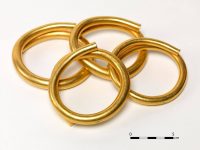 A farmer in Ireland has discovered four solid gold bracelets dating to at least as far back as the Bronze Age. A mechanical digger operator hired by farmer Norman Witherow was digging a drain in a field near Convoy, County Donegal, on Saturday, June 23rd, when he found four ring-shaped object encrusted with thick clay. They were about two feet beneath the surface, hidden under a rock that had thankfully protected them from being damaged by the digger.
A farmer in Ireland has discovered four solid gold bracelets dating to at least as far back as the Bronze Age. A mechanical digger operator hired by farmer Norman Witherow was digging a drain in a field near Convoy, County Donegal, on Saturday, June 23rd, when he found four ring-shaped object encrusted with thick clay. They were about two feet beneath the surface, hidden under a rock that had thankfully protected them from being damaged by the digger.
Witherow, not having any idea what they were other than that their shape and size suggested they might be bracelets, took them home and rinsed them off in his kitchen. They were gold in color, but he couldn’t tell if they were made of gold or copper or another yellow metal. The tubular shapes had a smooth surface and looped around, the closed terminal ends overlapping each other. Witherow put them on a scale and found they weighed 1.7 ounces.
He showed the pieces to a friend in the jewelry business and she responded with enthusiasm that they were something special and should be reported to the authorities. Witherow called the Donegal County Museum and reported the find to Assistant Curator Caroline Carr. She did an initial examination of the find site and on Tuesday, June 26th, called the National Museum of Ireland. The next day Maeve Sikora, the museum’s Keeper of Irish Antiquities, met Witherow in Dublin and took possession of the bracelets. National Museum experts also surveyed the find site for evidence of how, when and potentially why the objects were deposited.
Sikora’s initial examination of the gold objects suggests they may be from the Bronze Age (2500-500 B.C.), but they could be even older. As far as their use, they could be jewelry — bracelets, arm bands — but they could also have been used as a form of currency. It’s all hypothetical at this early stage of the investigation.
The National Museum will continue to study them, assess their gold content and seek more information about their origin and deposition. It is keen, however, to put them on display as quickly as possible, so expect some (maybe even all) to be on view as soon as the initial analyses are completed. The research will proceed after they’re on display.
A Golden Day
I was privileged to see the #gold artefacts today found in Donegal and now being examined @NMIrelandIt’s believed they are 3,000 years old, from the #BronzeAge & will undoubtedly add to our knowledge & understanding of our ancestors @lscarff @DeptAHG pic.twitter.com/Y0zfxzubIc
— ⚖️Josepha Madigan (@josephamadigan) June 28, 2018